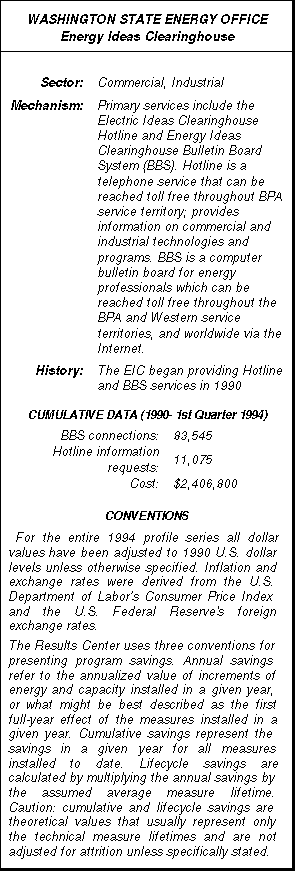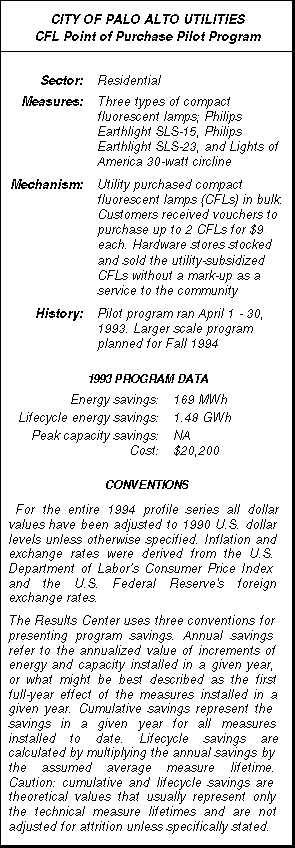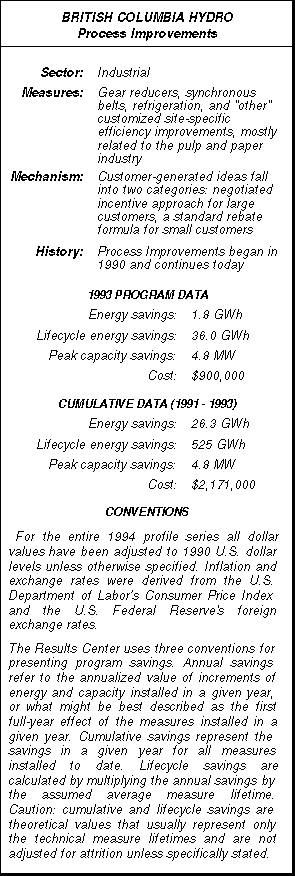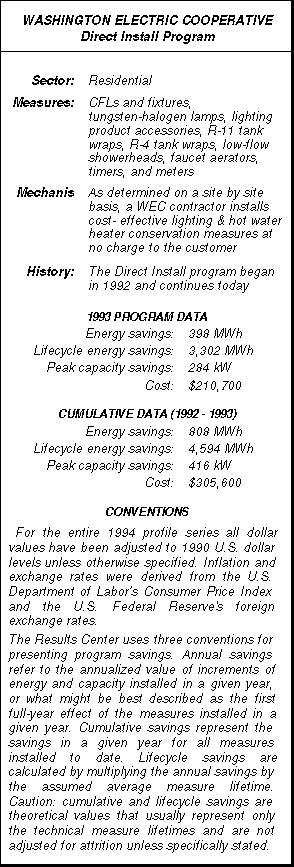EXECUTIVE SUMMARY
 In the mid-1980s, as the Bonneville Power Administration began to ramp up its commercial and industrial demand-side management activities, it recognized the need for a central source for detailed information on energy-efficient technologies. It sought to create a clearinghouse and after a competitive bid awarded the job to the Washington State Energy Office (WSEO). In 1990 WSEO established the Electric Ideas Clearinghouse (EIC, now known as the Energy Ideas Clearinghouse), a free information source for commercial and industrial energy projects in the Northwest.
In the mid-1980s, as the Bonneville Power Administration began to ramp up its commercial and industrial demand-side management activities, it recognized the need for a central source for detailed information on energy-efficient technologies. It sought to create a clearinghouse and after a competitive bid awarded the job to the Washington State Energy Office (WSEO). In 1990 WSEO established the Electric Ideas Clearinghouse (EIC, now known as the Energy Ideas Clearinghouse), a free information source for commercial and industrial energy projects in the Northwest.
The EIC has two primary services for utilities, engineers, designers, architects, and other energy professionals, as well as general energy consumers: a telephone/FAX hotline and a computer bulletin board (BBS). For the hotline (which is toll-free in the Northwest), WSEO’s initial response time to requests is typically under eight hours. To provide responses, WSEO staff, a network of engineers, librarians, energy specialists, and communication specialists, access an assortment of reference materials. The EIC (in combination with the WSEO library) has the largest energy library in the Northwest, and maintains seven consulting firms on a retainer basis.
The bulletin board is also toll-free in the Northwest and has recently extended its toll-free range thanks to new funding sources. Up to 28 people can access the system simultaneously and it is also linked with the Internet so that the EIC’s information can be accessed around the world. The BBS provides users with several services including E-mail, calendars of energy-related events, software libraries, discussion forums (some of which are private), job and resume listings, commercial energy codes, and other pertinent state and federal legislation. Currently new users are being added at a rate of 15-20 per day.
The Energy Ideas Clearinghouse provides an invaluable service in the Northwest and for the western states. While quantifying its effect is impossible, the Clearinghouse stands at the nexus of two concurrent revolutions: First, EIC is squarely positioned in the information revolution. Consumers in New York, for example, could just as easily access the Hotline and BBS as utility customers in Seattle. Second, EIC is clearly in line with the changing demand-side management paradigm. As utilities attempt to revamp their DSM programs -- shifting from direct customer incentives to a greater reliance on information -- the role of EIC and its importance in promoting customer-driven energy efficiency initiatives, will likely increase.
[CLICK HERE TO DOWNLOAD THE ENTIRE 19 PAGE PROFILE IN PDF FILE FORMAT]
This profile was produced by 

 The City of Palo Alto operates a combined municipal utility that serves electricity, gas, and water. Several factors make this relatively small utility an interesting case study for energy efficiency: First, Palo Alto is a highly-educated community. Second, the City has among the lowest electricity rates in California. Third, since its service territory is adjacent to Pacific Gas & Electric, one of the nation’s leading DSM utilities, residents of Palo Alto have come to expect progressive energy efficiency programs.
The City of Palo Alto operates a combined municipal utility that serves electricity, gas, and water. Several factors make this relatively small utility an interesting case study for energy efficiency: First, Palo Alto is a highly-educated community. Second, the City has among the lowest electricity rates in California. Third, since its service territory is adjacent to Pacific Gas & Electric, one of the nation’s leading DSM utilities, residents of Palo Alto have come to expect progressive energy efficiency programs. The Process Improvements program offered by B.C. Hydro Power Smart is administered by Willis Energy Services Limited. It is an excellent model of a program designed to promote and financially support innovation in the pursuit of energy efficiency for large industrial customers. The program has proven that sophisticated retrofits in the industrial sector can be catalyzed and bought at a low cost from a utility perspective.
The Process Improvements program offered by B.C. Hydro Power Smart is administered by Willis Energy Services Limited. It is an excellent model of a program designed to promote and financially support innovation in the pursuit of energy efficiency for large industrial customers. The program has proven that sophisticated retrofits in the industrial sector can be catalyzed and bought at a low cost from a utility perspective. Washington Electric Cooperative, Inc. (WEC) is a rural electric cooperative located in middle-eastern Vermont and has a service area density of 6.3 customers per mile of line. WEC began its DSM efforts in 1992 and now implements an impressive roster of seven DSM programs. WEC’s total DSM expenditure for 1993 was equal to nearly 6% of its gross revenues and its DSM budget for 1994 represents 10% of projected gross revenues, a commitment and level of investment unparalleled by most other utilities.
Washington Electric Cooperative, Inc. (WEC) is a rural electric cooperative located in middle-eastern Vermont and has a service area density of 6.3 customers per mile of line. WEC began its DSM efforts in 1992 and now implements an impressive roster of seven DSM programs. WEC’s total DSM expenditure for 1993 was equal to nearly 6% of its gross revenues and its DSM budget for 1994 represents 10% of projected gross revenues, a commitment and level of investment unparalleled by most other utilities.